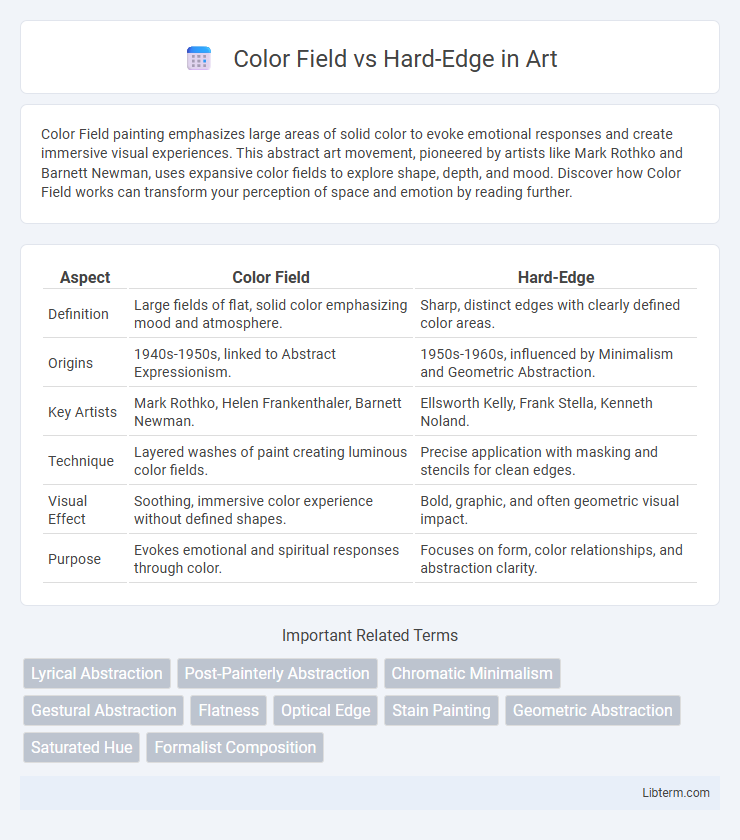Color Field painting emphasizes large areas of solid color to evoke emotional responses and create immersive visual experiences. This abstract art movement, pioneered by artists like Mark Rothko and Barnett Newman, uses expansive color fields to explore shape, depth, and mood. Discover how Color Field works can transform your perception of space and emotion by reading further.
Table of Comparison
| Aspect | Color Field | Hard-Edge |
|---|---|---|
| Definition | Large fields of flat, solid color emphasizing mood and atmosphere. | Sharp, distinct edges with clearly defined color areas. |
| Origins | 1940s-1950s, linked to Abstract Expressionism. | 1950s-1960s, influenced by Minimalism and Geometric Abstraction. |
| Key Artists | Mark Rothko, Helen Frankenthaler, Barnett Newman. | Ellsworth Kelly, Frank Stella, Kenneth Noland. |
| Technique | Layered washes of paint creating luminous color fields. | Precise application with masking and stencils for clean edges. |
| Visual Effect | Soothing, immersive color experience without defined shapes. | Bold, graphic, and often geometric visual impact. |
| Purpose | Evokes emotional and spiritual responses through color. | Focuses on form, color relationships, and abstraction clarity. |
Introduction to Abstract Art Movements
Color Field painting emphasizes large, solid areas of color to evoke emotional responses through simplicity and spatial depth, pioneered by artists like Mark Rothko and Barnett Newman. Hard-Edge painting contrasts with its precise, sharply defined geometric shapes and crisp boundaries, exemplified by Ellsworth Kelly and Frank Stella. Both movements emerged in the mid-20th century as key developments in abstract art, shifting focus from gestural brushwork to color and form purity.
Defining Color Field Painting
Color Field painting emphasizes large expanses of solid color spread across or stained into the canvas to evoke emotional resonance through simplicity and chromatic intensity. Unlike Hard-Edge painting, which features sharp, precise boundaries and distinct geometric forms, Color Field artists prioritize fluidity and subtle tonal variations to create immersive visual experiences. Key figures such as Mark Rothko and Helen Frankenthaler exemplify this movement by using color as the primary subject matter rather than relying on line or form.
Understanding Hard-Edge Abstraction
Hard-edge abstraction emphasizes sharp lines and clearly defined shapes with distinct, unmodulated colors, creating precise visual contrasts and geometric clarity. This style contrasts with Color Field painting, which focuses on large areas of blended or subtle color gradients to evoke emotional depth and atmospheric effects. Understanding hard-edge abstraction involves recognizing the deliberate use of flat, solid colors and crisp boundaries to convey a sense of order and structure within abstract expression.
Key Characteristics: Color Field vs Hard-Edge
Color Field painting emphasizes large areas of solid color with subtle variations and soft, blurred edges to evoke emotion and immerse the viewer in expansive color experiences. Hard-Edge painting features sharp, clean lines and distinct color boundaries, creating geometric shapes that emphasize clarity, precision, and spatial tension. Both styles explore abstract expressionism but differ in technique, with Color Field focusing on fluidity and atmosphere, while Hard-Edge prioritizes structure and definition.
Influential Artists and Their Contributions
Color Field painting, exemplified by Mark Rothko and Barnett Newman, emphasizes large, flat areas of color to evoke emotional resonance and spiritual depth. Hard-Edge painting, pioneered by artists like Ellsworth Kelly and Frank Stella, focuses on sharp, clean lines and geometric shapes, creating a precise and impersonal aesthetic. Both movements significantly shaped Abstract Expressionism's evolution by expanding the use of color and form as central expressive elements.
Notable Techniques and Materials Used
Color Field painting emphasizes large swaths of translucent color created with thinned oil or acrylic paints on unprimed or raw canvas, utilizing techniques like staining to achieve seamless color transitions. Hard-Edge painting relies on crisp, defined contours and flat areas of solid color, often applying acrylic paints with masking tape or stencils on primed canvas or panels to maintain sharp boundaries. Both movements exploit the flatness of the canvas but differ as Color Field favors fluid, immersive color experiences while Hard-Edge prioritizes geometric precision and visual clarity.
Visual Impact and Viewer Experience
Color Field painting emphasizes large, sweeping areas of unified color that create a meditative and immersive visual impact, encouraging viewers to engage emotionally and intuitively with the artwork. Hard-Edge painting utilizes sharp, geometric boundaries and contrasting hues to generate a dynamic and precise visual experience, stimulating cognitive recognition and a sense of spatial clarity. Both styles influence viewer perception: Color Field fosters atmospheric depth, while Hard-Edge promotes crisp visual tension and structural focus.
Historical Evolution and Timeline
Color Field painting emerged in the late 1940s and early 1950s, characterized by large areas of solid color emphasizing flatness and simplicity, with key artists like Mark Rothko and Barnett Newman leading the movement. Hard-Edge painting developed slightly later, during the late 1950s and 1960s, defined by crisp, geometric shapes with sharply defined edges and artists such as Ellsworth Kelly and Frank Stella. Both movements evolved as offshoots of Abstract Expressionism, with Color Field emphasizing emotional depth through color expanses, and Hard-Edge focusing on precision and clarity through distinct forms.
Cultural and Artistic Significance
Color Field painting emphasizes large areas of solid color that evoke emotional resonance and spiritual depth, reflecting post-World War II introspection and a move towards abstract expressionism. Hard-Edge painting, characterized by sharp, clean lines and geometric precision, symbolizes a shift towards modernism and industrial culture, often highlighting clarity and order in a rapidly changing society. Both movements significantly influenced mid-20th-century art, challenging traditional representation and expanding the language of abstraction with distinct cultural narratives.
Contemporary Legacy and Influence
Color Field painting, characterized by large, sweeping areas of color, profoundly influenced contemporary abstract art by inspiring immersive spatial experiences and emotional resonance through hue and tone. Hard-Edge painting, defined by sharply delineated areas of color and precise geometric forms, continues to impact modern design and minimalism, emphasizing clarity and structural order. Both movements underpin contemporary practices by challenging traditional composition and fostering new dialogues on color interaction and perceptual engagement.
Color Field Infographic

 libterm.com
libterm.com